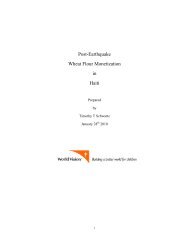Right to Livelihoods in Haiti
Focus on egg production and rural household livelihood strategies
Focus on egg production and rural household livelihood strategies
You also want an ePaper? Increase the reach of your titles
YUMPU automatically turns print PDFs into web optimized ePapers that Google loves.
16<br />
Constra<strong>in</strong>ts <strong>to</strong> Produc<strong>in</strong>g Eggs<br />
Feed<br />
The first and most important limitation on egg production on rural homesteads is the same as that<br />
encountered at the <strong>in</strong>dustrial level seen earlier, the cost of feed. As seen, not any feed will do. A lay<strong>in</strong>g<br />
chicken requires very carefully balanced feed that <strong>in</strong>cludes the right salts, calcium and vitam<strong>in</strong>s. One has<br />
<strong>to</strong> buy that feed, not easy <strong>to</strong> f<strong>in</strong>d <strong>in</strong> rural <strong>Haiti</strong> (see Constra<strong>in</strong>ts on Intensive Egg Production, p 5). If the<br />
farmer can get it from <strong>Haiti</strong> Broilers then he or she can produce an egg for USD $0.11 cents. And that is<br />
basically the only hope the farmer has because even if the farmer can concoct the appropriate feed<br />
ratios—a feat for the most sophisticated farmer -- currently retail corn prices (100 Htg for 1 mamit =<br />
approximately 5.5 lbs) mean that at a conversion ratio of 4.6 pounds of feed one 1 dozen egg, the feed<br />
for an egg would cost exactly what it is worth on the retail market (7 <strong>to</strong> 8 Htg). And that is assum<strong>in</strong>g that<br />
the farmer could get optimum <strong>in</strong>dustrial yield for the egg, someth<strong>in</strong>g he or she could not hope <strong>to</strong> come<br />
close <strong>to</strong>. But that is not the worst of it. Corn <strong>in</strong> rural <strong>Haiti</strong> can vary seasonally by fac<strong>to</strong>rs as great as 300%,<br />
so it at times it could cost 200% <strong>to</strong> 300% percent the given figure. If the farmers grows his or her own corn<br />
then, as seen earlier, it would make much more sense <strong>to</strong> forget about chickens and sell the corn. The only<br />
hope the farmer has, the only hope, is that when all is done he or she can sell the hens for slaughter and<br />
recuperate more than was lost. All of this makes feed<strong>in</strong>g chickens highly <strong>in</strong>auspicious undertak<strong>in</strong>g with<strong>in</strong><br />
the ‘low risk, low cost’ livelihood strategies that have enabled <strong>Haiti</strong>an peasants <strong>to</strong> survive for two<br />
centuries. With the price of gra<strong>in</strong> <strong>in</strong> m<strong>in</strong>d, it is easy <strong>to</strong> understand why poultry production <strong>in</strong> rural <strong>Haiti</strong> is<br />
xxiv xxv xxvi xxvii<br />
typically based on scaveng<strong>in</strong>g strategy, which leads <strong>to</strong> a whole series of additional constra<strong>in</strong>ts<br />
Constra<strong>in</strong>s that Derive from the Scaveng<strong>in</strong>g Strategy<br />
Because free rang<strong>in</strong>g chickens will heartily scarf up any seeds they f<strong>in</strong>d means that they must be conf<strong>in</strong>ed<br />
dur<strong>in</strong>g plant<strong>in</strong>g and harvest seasons. If they are not conf<strong>in</strong>ed and they <strong>in</strong>vade a newly planted garden or<br />
help themselves <strong>to</strong> the neighbors dry<strong>in</strong>g corn, the neighbors have a right and often do kill them, often<br />
bait<strong>in</strong>g them with rat poison. Because an effective chicken coup costs money--and as seen rural <strong>Haiti</strong>ans<br />
employ low risk and low <strong>in</strong>vestment strategies--the vast majority do not have coups. Rather they tether<br />
the chickens, which means tend<strong>in</strong>g them, mov<strong>in</strong>g them, water<strong>in</strong>g them, all of which puts a limitation<br />
dur<strong>in</strong>g plant<strong>in</strong>g and harvest seasons on the number that can be reasonably be looked after before they<br />
start dy<strong>in</strong>g from neglect. Indeed, the more chickens one has the more all the prior problems mentioned,<br />
the greater the costs, the risks, and the losses, all directly anathema <strong>to</strong> the major logical tenet underly<strong>in</strong>g<br />
rural <strong>Haiti</strong>an subsistence strategies: lost <strong>in</strong>vestment and low risk.<br />
Disease and Supplements<br />
To adequately care for a chick they should be given vacc<strong>in</strong>es aga<strong>in</strong>st Newcastle disease, and cocsidosis.<br />
They should be wormed and given vitam<strong>in</strong> supplements and preventative antibiotic, all of which is difficult<br />
<strong>to</strong> purchase for few birds and so much be bought <strong>in</strong> bulk at the cost of USD$20 <strong>to</strong> 30, more than half of<br />
what most rural farmers earn annually on chickens. Meds and nutrition will not s<strong>to</strong>p preda<strong>to</strong>rs, which as<br />
seen annually take 30% of the flock. Moreover, it is not as simple as vacc<strong>in</strong>at<strong>in</strong>g a chicken for life. To<br />
effectively deal with epidemics and new chicks, FAO recommends farmers vacc<strong>in</strong>ate their entire flock of<br />
free-rang<strong>in</strong>g birds monthly, mak<strong>in</strong>g it a frequent cost and <strong>in</strong>convenient chore not acceptable <strong>to</strong> most<br />
farmers. On <strong>to</strong>p of all this, <strong>in</strong> most areas the vacc<strong>in</strong>es simply are not available. In the best cases, supplies<br />
from the M<strong>in</strong>istry of Agricultural (MARNDR) are sporadic. In the other cases, such as Les Cayes, there is a<br />
function<strong>in</strong>g and well s<strong>to</strong>cked s<strong>to</strong>re, but farmers must travel <strong>to</strong> get <strong>to</strong> it. xxviii
















